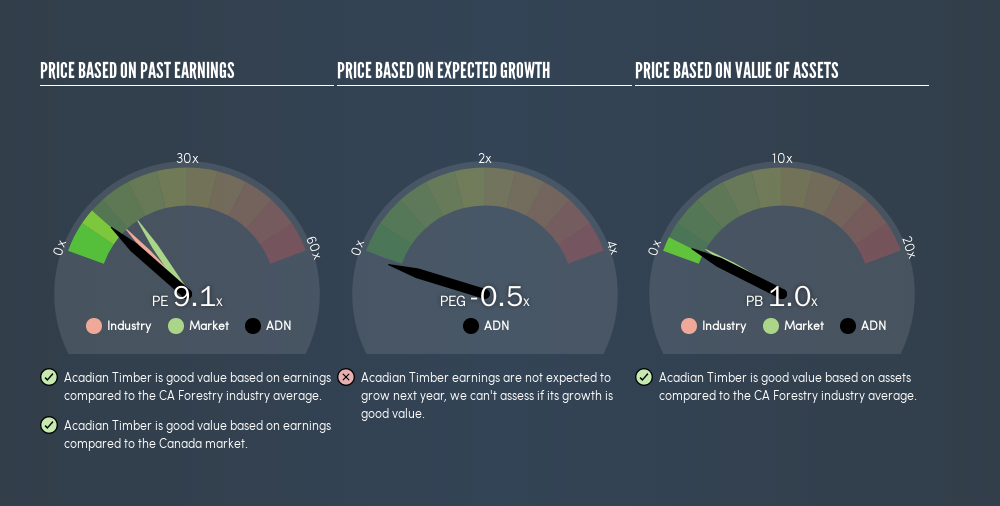- Canada
- /
- Paper and Forestry Products
- /
- TSX:ADN
Here's How P/E Ratios Can Help Us Understand Acadian Timber Corp. (TSE:ADN)

The goal of this article is to teach you how to use price to earnings ratios (P/E ratios). We'll apply a basic P/E ratio analysis to Acadian Timber Corp.'s (TSE:ADN), to help you decide if the stock is worth further research. Acadian Timber has a price to earnings ratio of 9.13, based on the last twelve months. That corresponds to an earnings yield of approximately 11%.
View our latest analysis for Acadian Timber
How Do You Calculate A P/E Ratio?
The formula for price to earnings is:
Price to Earnings Ratio = Share Price ÷ Earnings per Share (EPS)
Or for Acadian Timber:
P/E of 9.13 = CA$16.64 ÷ CA$1.82 (Based on the year to March 2019.)
Is A High Price-to-Earnings Ratio Good?
A higher P/E ratio implies that investors pay a higher price for the earning power of the business. That isn't necessarily good or bad, but a high P/E implies relatively high expectations of what a company can achieve in the future.
Does Acadian Timber Have A Relatively High Or Low P/E For Its Industry?
We can get an indication of market expectations by looking at the P/E ratio. The image below shows that Acadian Timber has a lower P/E than the average (11.5) P/E for companies in the forestry industry.

This suggests that market participants think Acadian Timber will underperform other companies in its industry.
How Growth Rates Impact P/E Ratios
P/E ratios primarily reflect market expectations around earnings growth rates. That's because companies that grow earnings per share quickly will rapidly increase the 'E' in the equation. That means unless the share price increases, the P/E will reduce in a few years. Then, a lower P/E should attract more buyers, pushing the share price up.
Acadian Timber saw earnings per share improve by -8.6% last year. And its annual EPS growth rate over 5 years is 36%.
Don't Forget: The P/E Does Not Account For Debt or Bank Deposits
Don't forget that the P/E ratio considers market capitalization. That means it doesn't take debt or cash into account. The exact same company would hypothetically deserve a higher P/E ratio if it had a strong balance sheet, than if it had a weak one with lots of debt, because a cashed up company can spend on growth.
Such spending might be good or bad, overall, but the key point here is that you need to look at debt to understand the P/E ratio in context.
Acadian Timber's Balance Sheet
Acadian Timber's net debt equates to 26% of its market capitalization. While that's enough to warrant consideration, it doesn't really concern us.
The Verdict On Acadian Timber's P/E Ratio
Acadian Timber trades on a P/E ratio of 9.1, which is below the CA market average of 15.5. EPS grew over the last twelve months, and debt levels are quite reasonable. The P/E ratio implies the market is cautious about longer term prospects.
Investors have an opportunity when market expectations about a stock are wrong. As value investor Benjamin Graham famously said, 'In the short run, the market is a voting machine but in the long run, it is a weighing machine.' So this free visual report on analyst forecasts could hold the key to an excellent investment decision.
Of course, you might find a fantastic investment by looking at a few good candidates. So take a peek at this free list of companies with modest (or no) debt, trading on a P/E below 20.
We aim to bring you long-term focused research analysis driven by fundamental data. Note that our analysis may not factor in the latest price-sensitive company announcements or qualitative material.
If you spot an error that warrants correction, please contact the editor at editorial-team@simplywallst.com. This article by Simply Wall St is general in nature. It does not constitute a recommendation to buy or sell any stock, and does not take account of your objectives, or your financial situation. Simply Wall St has no position in the stocks mentioned. Thank you for reading.
About TSX:ADN
Acadian Timber
Provides forest products in Eastern Canada and the Northeastern United States.
Excellent balance sheet established dividend payer.
Similar Companies
Market Insights
Community Narratives



